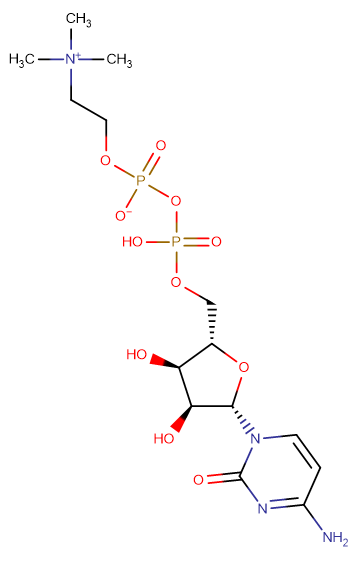
Citicoline
CAS No. 987-78-0
Citicoline( Citicoline | Cytidine 5-diphosphocholine | Cdp-choline | Cdp choline )
Catalog No. M16900 CAS No. 987-78-0
Donor of choline in biosynthesis of choline-containing phosphoglycerides.
Purity : >98% (HPLC)
 COA
COA
 Datasheet
Datasheet
 HNMR
HNMR
 HPLC
HPLC
 MSDS
MSDS
 Handing Instructions
Handing Instructions
| Size | Price / USD | Stock | Quantity |
| 50MG | 27 | In Stock |


|
| 100MG | 38 | In Stock |


|
| 200MG | 48 | In Stock |


|
| 500MG | 67 | In Stock |


|
| 1G | Get Quote | In Stock |


|
Biological Information
-
Product NameCiticoline
-
NoteResearch use only, not for human use.
-
Brief DescriptionDonor of choline in biosynthesis of choline-containing phosphoglycerides.
-
DescriptionDonor of choline in biosynthesis of choline-containing phosphoglycerides.(In Vitro):To determine the potential neuroprotective activity of Citicoline and Homotaurine, treated retinal cells are treated with increasing concentrations of Citicoline or Homotaurine for 24 hours. 1?μM, 10?μM and 100?μM of Citicoline or Homotaurine are used to investigate whether may contribute to a reduced cell viability in retinal cells. Retinal cells are well preserved in Citicoline- or Homotaurine-treated cultures, with no evidence of toxicity or significant loss of viability after treatments. 100?μM of Citicoline is not harmful to retinal neuroglial cells in vitro and 100?μM of Homotaurine is an effective concentration to enhance neuroprotection in a model of experimental glaucoma. Therefore, this concentration of Citicoline and Homotaurine is used for all subsequent experiments. To evaluate whether cotreatment with Citicoline and Homotaurine is able to induce a synergistic neuroprotective effect against glutamate excitotoxicity, retinal cell cultures are exposed to Citicoline 100?μM, Homotaurine 100?μM, and Citicoline+Homotaurine 100?μM, 24 hours before glutamate treatment. In the presence of 100?μM Citicoline, a significant increase in cell viability is observed.(In Vivo):Administration of Citicoline in a dose of 1000 mg/kg produces more pronounced increase in the threshold of clonic seizures and tonic phase of seizures with lethal outcome (by 18.54 and 50.08% respectively, in comparison with the control). The anticonvulsant effect is most pronounced after injection of Citicoline in a dose of 1000 mg/kg.
-
In VitroTo determine the potential neuroprotective activity of Citicoline and Homotaurine, treated retinal cells are treated with increasing concentrations of Citicoline or Homotaurine for 24 hours. 1?μM, 10?μM and 100?μM of Citicoline or Homotaurine are used to investigate whether may contribute to a reduced cell viability in retinal cells. Retinal cells are well preserved in Citicoline- or Homotaurine-treated cultures, with no evidence of toxicity or significant loss of viability after treatments. 100?μM of Citicoline is not harmful to retinal neuroglial cells in vitro and 100?μM of Homotaurine is an effective concentration to enhance neuroprotection in a model of experimental glaucoma. Therefore, this concentration of Citicoline and Homotaurine is used for all subsequent experiments. To evaluate whether cotreatment with Citicoline and Homotaurine is able to induce a synergistic neuroprotective effect against glutamate excitotoxicity, retinal cell cultures are exposed to Citicoline 100?μM, Homotaurine 100?μM, and Citicoline+Homotaurine 100?μM, 24 hours before glutamate treatment. In the presence of 100?μM Citicoline, a significant increase in cell viability is observed.
-
In VivoAdministration of Citicoline in a dose of 1000 mg/kg produces more pronounced increase in the threshold of clonic seizures and tonic phase of seizures with lethal outcome (by 18.54 and 50.08% respectively, in comparison with the control). The anticonvulsant effect is most pronounced after injection of Citicoline in a dose of 1000 mg/kg.
-
SynonymsCiticoline | Cytidine 5-diphosphocholine | Cdp-choline | Cdp choline
-
PathwayGPCR/G Protein
-
TargetDopamine Receptor
-
RecptorDopamine
-
Research Area——
-
Indication——
Chemical Information
-
CAS Number987-78-0
-
Formula Weight488.32
-
Molecular FormulaC14H26N4O11P2
-
Purity>98% (HPLC)
-
SolubilityDMSO: 10 mM
-
SMILESC[N+](CCOP(OP(O)(OC[C@@H]1O[C@H](N2C=CC(N)=NC2=O)[C@@H](O)[C@H]1O)=O)([O-])=O)(C)C
-
Chemical Name2-(((((((2S,3R,4S,5S)-5-(4-amino-2-oxopyrimidin-1(2H)-yl)-3,4-dihydroxytetrahydrofuran-2-yl)methoxy)(hydroxy)phosphoryl)oxy)oxidophosphoryl)oxy)-N,N,N-trimethylethan-1-aminium
Shipping & Storage Information
-
Storage(-20℃)
-
ShippingWith Ice Pack
-
Stability≥ 2 years
Reference
1.Giménez R, et al. Br J Pharmacol. 1991 Nov;104(3):575-8.
molnova catalog



related products
-
Acetophenazine dimal...
Acetophenazine dimaleate is an antipsychotic agent, effective in anxious depression. Acetophenazine dimaleate primarily targets the dopamine D2 receptor.
-
Rotigotine hydrochlo...
A non-selective agonist of the dopamine D3 receptor (Ki=0.71 nM); has 10-fold selectivity for the D3 receptor over the D2, D4, and D5 receptors and 100-fold selectivity for the D3 receptor over the D1 receptor.
-
PF-00217830
PF-00217830 is a serotonin 1A receptor agonist, dopamine D2 receptor agonist, and serotonin 2A receptor antagonist.PF-00217830 may be used in the study of schizophrenia.



 Cart
Cart
 sales@molnova.com
sales@molnova.com


